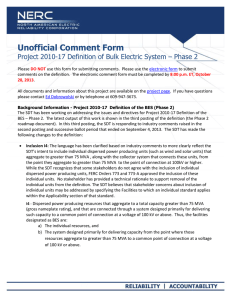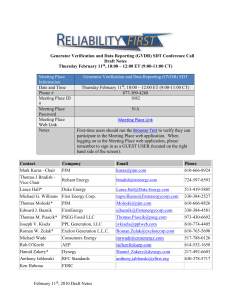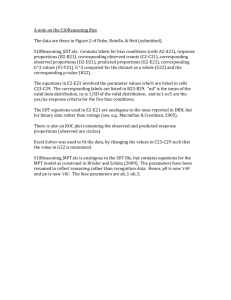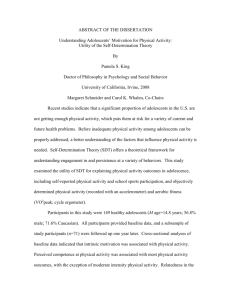NERC Document_Portrait (Unofficial Comment Form)
advertisement
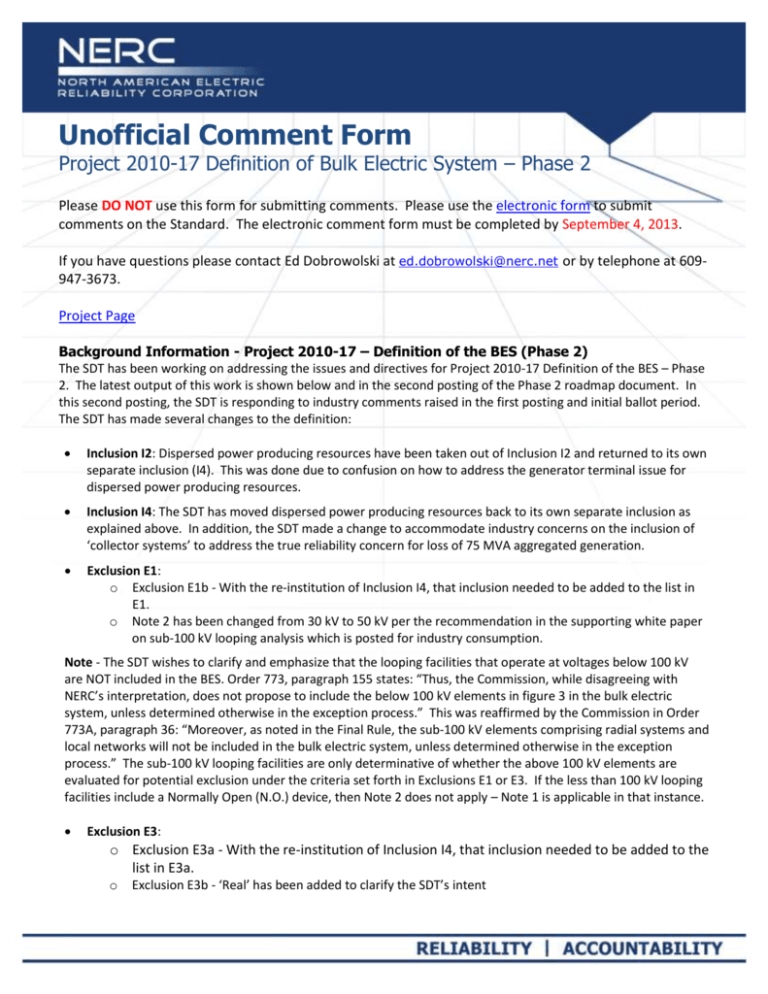
Unofficial Comment Form Project 2010-17 Definition of Bulk Electric System – Phase 2 Please DO NOT use this form for submitting comments. Please use the electronic form to submit comments on the Standard. The electronic comment form must be completed by September 4, 2013. If you have questions please contact Ed Dobrowolski at ed.dobrowolski@nerc.net or by telephone at 609947-3673. Project Page Background Information - Project 2010-17 – Definition of the BES (Phase 2) The SDT has been working on addressing the issues and directives for Project 2010-17 Definition of the BES – Phase 2. The latest output of this work is shown below and in the second posting of the Phase 2 roadmap document. In this second posting, the SDT is responding to industry comments raised in the first posting and initial ballot period. The SDT has made several changes to the definition: Inclusion I2: Dispersed power producing resources have been taken out of Inclusion I2 and returned to its own separate inclusion (I4). This was done due to confusion on how to address the generator terminal issue for dispersed power producing resources. Inclusion I4: The SDT has moved dispersed power producing resources back to its own separate inclusion as explained above. In addition, the SDT made a change to accommodate industry concerns on the inclusion of ‘collector systems’ to address the true reliability concern for loss of 75 MVA aggregated generation. Exclusion E1: o Exclusion E1b - With the re-institution of Inclusion I4, that inclusion needed to be added to the list in E1. o Note 2 has been changed from 30 kV to 50 kV per the recommendation in the supporting white paper on sub-100 kV looping analysis which is posted for industry consumption. Note - The SDT wishes to clarify and emphasize that the looping facilities that operate at voltages below 100 kV are NOT included in the BES. Order 773, paragraph 155 states: “Thus, the Commission, while disagreeing with NERC’s interpretation, does not propose to include the below 100 kV elements in figure 3 in the bulk electric system, unless determined otherwise in the exception process.” This was reaffirmed by the Commission in Order 773A, paragraph 36: “Moreover, as noted in the Final Rule, the sub-100 kV elements comprising radial systems and local networks will not be included in the bulk electric system, unless determined otherwise in the exception process.” The sub-100 kV looping facilities are only determinative of whether the above 100 kV elements are evaluated for potential exclusion under the criteria set forth in Exclusions E1 or E3. If the less than 100 kV looping facilities include a Normally Open (N.O.) device, then Note 2 does not apply – Note 1 is applicable in that instance. Exclusion E3: o Exclusion E3a - With the re-institution of Inclusion I4, that inclusion needed to be added to the list in E3a. o Exclusion E3b - ‘Real’ has been added to clarify the SDT’s intent Exclusion E4: Pluralized the customer term. Question 1 deals with the changes made to Inclusions I2 and I4. A diagram is provided here for reference on how one particular configuration would be interpreted by the SDT under these revisions. As part of the review of these changes, the SDT wishes to remind the industry that the approved Phase 1 definition included the individual dispersed power producing resources in situations where they aggregated to 75 MVA prior to connecting to the BES. Nothing introduced in Phase 2 has changed this approved condition. I2 – Generating resource(s) including the generator terminals through the high-side of the step-up transformer(s) connected at a voltage of 100 kV or above with: I4 - Dispersed power producing resources consisting of: a) Individual resources that aggregate to a total capacity greater than 75 MVA (gross nameplate rating), and b) The system designed primarily for delivering capacity from the point where those resources aggregate to greater than 75 MVA to a common point of connection at a voltage of 100 kV or above. Typical dispersed generation site and substation design with a gross aggregate nameplate rating of 80 MVA (Individual Generator Unit Rating: 2 MVA). By application of Inclusion I4 the dispersed power producing resources and the Elements from the point of aggregation at 75 MVA to the common point connection are BES Elements. Green identifies non-BES portions of the Collector System. Blue identifies the dispersed power producing resources and BES Elements . < 100kV / < 100kV < 100kV / < 100kV < 100kV / < 100kV < 100kV / > 100kV < 100kV / < 100kV > 100kV < 100kV / < 100kV < 100kV / < 100kV The point of aggregation is where the individual generator name plate ratings of the dispersed generation total > 75 MVA (actual 80 MVA) and a single point failure would result in loss of all generation contained on the dispersed generation site. The common point of connection is where the individual transmission Element(s) of the collector system is connected to the 100 kV or higher Transmission system. (Note: This point is typically specified in the respective Transmission Owner and Generator Operator Interconnection Agreements.) Unofficial Comment Form Project 2010-17 Definition of Bulk Electric System – Phase 2 (Second Draft) 2 Question 2 deals with the change from 30 kV to 50 kV in Exclusion E1, Note 2. Note 2 – The presence of a contiguous loop, operated at a voltage level of 50 kV or less, between configurations being considered as radial systems, does not affect this exclusion. The SDT has proposed an equal and effective alternative to the issue of sub-100 kV loop analysis with respect to Exclusion E1. The SDT has proposed a threshold of 50 kV or less for loops between radial systems when considering the application of Exclusion E1. The SDT used a two step approach to determine the voltage level. As a first step, regional voltage levels that are monitored on major interfaces, paths, and monitored elements to ensure the reliable operation of the interconnected transmission system were examined to determine the lowest monitored voltage level. Next, power system analyses determined the maximum amount of power that can be transferred through the low voltage systems, when looped, under a worst case scenario at various voltage levels. A formal white paper has been prepared to support this approach and is included with this posting. Note - The SDT wishes to clarify and emphasize that the looping facilities that operate at voltages below 100 kV are NOT included in the BES. Order 773, paragraph 155 states: “Thus, the Commission, while disagreeing with NERC’s interpretation, does not propose to include the below 100 kV elements in figure 3 in the bulk electric system, unless determined otherwise in the exception process.” This was reaffirmed by the Commission in Order 773A, paragraph 36: “Moreover, as noted in the Final Rule, the sub-100 kV elements comprising radial systems and local networks will not be included in the bulk electric system, unless determined otherwise in the exception process.” The sub100 kV looping facilities are only determinative of whether the above 100 kV elements are evaluated for potential exclusion under the criteria set forth in Exclusions E1 or E3. Question 3 deals with the clarification to Exclusion E3b on Real Power. E3b - Real Power flows only into the LN and the LN does not transfer energy originating outside the LN for delivery through the LN; and Question 4 is a generic question added to accommodate any other industry concerns with the proposed Phase 2 definition. You do not have to answer all questions. Enter comments in simple text format. Bullets, numbers, and special formatting will not be retained. Questions The SDT has asked one specific question for each specific aspect of the definition. 1. The SDT has separated Inclusion I2 and I4 to provide the clarity requested by the industry in the first posting comments. In addition, again in response to industry comments, the SDT has added language to Inclusion I4b to identify the equipment from an aggregation point of greater than 75 MVA to the connection to the BES. Do you agree with these changes? If not, please provide technical rationale for your disagreement along with suggested language changes. Unofficial Comment Form Project 2010-17 Definition of Bulk Electric System – Phase 2 (Second Draft) 3 Yes: No: Comments: 2. The SDT has proposed an equally effective and efficient alternative to the Commission’s sub-100 kV loop concerns for radial systems by the addition of Note 2 in Exclusion E1 with a threshold value of 50 kV, and posted a technical rationale to support this threshold. Do you agree with this threshold? If you do not support this threshold, please provide specific suggestions and technical rationale in your comments. Yes: No: Comments: 3. The SDT has added the term ‘Real’ to Exclusion E3b to clarify its intent. Do you agree with this change? If you do not support this change, please provide specific suggestions and technical rationale in your comments. Yes: No: Comments: 4. Are there any other concerns with this definition that haven’t been covered in previous questions and comments? Yes: No: Comments: Unofficial Comment Form Project 2010-17 Definition of Bulk Electric System – Phase 2 (Second Draft) 4
